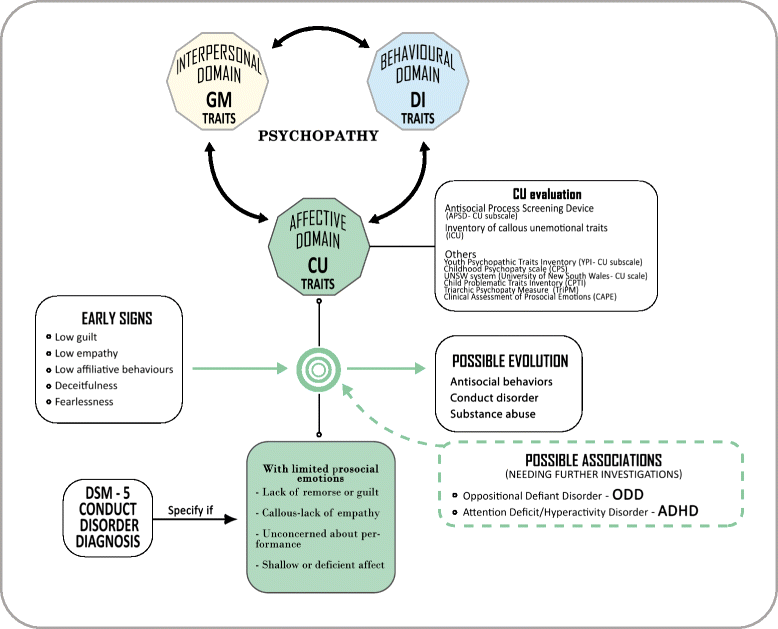Conduct disorders and psychopathy in children and adolescents: aetiology, clinical presentation and treatment strategies of callous-unemotional traits
- PMID: 28931400
- PMCID: PMC5607565
- DOI: 10.1186/s13052-017-0404-6
Conduct disorders and psychopathy in children and adolescents: aetiology, clinical presentation and treatment strategies of callous-unemotional traits
Abstract
Conduct Disorder (CD) is a psychiatric diagnosis characterized by a repetitive and persistent pattern of behaviour in which the basic rights of others and major age-appropriate social norms or rules are violated. Callous Unemotional (CU) traits are a meaningful specifier in subtyping CD for more severe antisocial and aggressive behaviours in adult psychopathology; they represent the affective dimension of adult psychopathy, but they can be also detected in childhood and adolescence. The CU traits include lack of empathy, sense of guilt and shallow emotion, and their characterization in youth can improve our diagnostic, prognostic and therapeutic abilities. A strong genetic liability, in interaction with parenting and relevant environmental factors, can lead to elevated levels of CU traits in children. We pointed out that CU traits can be detected in early childhood, may remain stable along the adolescence, but a decrease following intensive and specialized treatment is possible. We here provide a narrative review of the available evidences on CU traits in three main domains: aetiology (encompassing genetic liability and environmental risk factors), presentation (early signs and longitudinal trajectories) and treatments.
Keywords: Adolescents; Callous unemotional traits; Children; Conduct disorder; Psychopathy.
Conflict of interest statement
Ethics approval
Not applicable.
Consent for publication
Not applicable.
Competing interests
GM was in the advisory boards for Eli Lilly, Shire and Angelini, has received research grants from Eli Lilly, Shire, and Lundbeck, and has been speaker for FB, Eli Lilly, Shire, Lundbeck, and Otsuka. All the other authors declare that they have no competing interests.
Publisher’s Note
Springer Nature remains neutral with regard to jurisdictional claims in published maps and institutional affiliations.
Figures
Similar articles
-
Callous unemotional traits in children with disruptive behavior disorder: Predictors of developmental trajectories and adolescent outcomes.Psychiatry Res. 2016 Feb 28;236:35-41. doi: 10.1016/j.psychres.2016.01.003. Epub 2016 Jan 6. Psychiatry Res. 2016. PMID: 26791396
-
Which dimension of parenting predicts the change of callous unemotional traits in children with disruptive behavior disorder?Compr Psychiatry. 2016 Aug;69:202-10. doi: 10.1016/j.comppsych.2016.06.002. Epub 2016 Jun 14. Compr Psychiatry. 2016. PMID: 27423362
-
Intergenerational Stability of Callous-Unemotional Traits.Child Psychiatry Hum Dev. 2018 Jun;49(3):480-491. doi: 10.1007/s10578-017-0766-4. Child Psychiatry Hum Dev. 2018. PMID: 29119362
-
Extending the construct of psychopathy to youth: implications for understanding, diagnosing, and treating antisocial children and adolescents.Can J Psychiatry. 2009 Dec;54(12):803-12. doi: 10.1177/070674370905401203. Can J Psychiatry. 2009. PMID: 20047719 Review.
-
Can callous-unemotional traits enhance the understanding, diagnosis, and treatment of serious conduct problems in children and adolescents? A comprehensive review.Psychol Bull. 2014 Jan;140(1):1-57. doi: 10.1037/a0033076. Epub 2013 Jun 24. Psychol Bull. 2014. PMID: 23796269 Review.
Cited by
-
Animal Abuse as an Indicator of Domestic Violence: One Health, One Welfare Approach.Animals (Basel). 2022 Apr 10;12(8):977. doi: 10.3390/ani12080977. Animals (Basel). 2022. PMID: 35454224 Free PMC article. Review.
-
The bidirectional relationship between sleep and externalizing behavior: A systematic review.Sleep Epidemiol. 2022 Dec;2:100039. doi: 10.1016/j.sleepe.2022.100039. Epub 2022 Jul 29. Sleep Epidemiol. 2022. PMID: 38405369 Free PMC article.
-
Does the Interplay of Callous-Unemotional Traits and Moral Disengagement Underpin Disruptive Behavior? A Systematic Review.Adolesc Health Med Ther. 2020 Feb 3;11:9-20. doi: 10.2147/AHMT.S151699. eCollection 2020. Adolesc Health Med Ther. 2020. PMID: 32099503 Free PMC article. Review.
-
The evidence-based choice for antipsychotics in children and adolescents should be guaranteed.Eur J Clin Pharmacol. 2019 Jun;75(6):769-776. doi: 10.1007/s00228-019-02641-0. Epub 2019 Feb 7. Eur J Clin Pharmacol. 2019. PMID: 30729258 Review.
-
Anorexia nervosa, conduct disorder, and the juvenile justice system: a case of applying traditional treatment modalities in a non-traditional setting.Biopsychosoc Med. 2021 Dec 18;15(1):26. doi: 10.1186/s13030-021-00227-w. Biopsychosoc Med. 2021. PMID: 34922570 Free PMC article.
References
-
- Gritti A, Bravaccio C, Signoriello S, Salerno F, Pisano S, Catone G, et al. Epidemiological study on behavioural and emotional problems in developmental age: prevalence in a sample of Italian children, based on parent and teacher reports. Ital J Pediatr. 2014;40:19. doi: 10.1186/1824-7288-40-19. - DOI - PMC - PubMed
-
- American Psychiatric Association . Diagnostic and statistical manual of mental disorder - 5th ed. Washington, DC: Author; 2013.
Publication types
MeSH terms
LinkOut - more resources
Full Text Sources
Other Literature Sources
Medical


